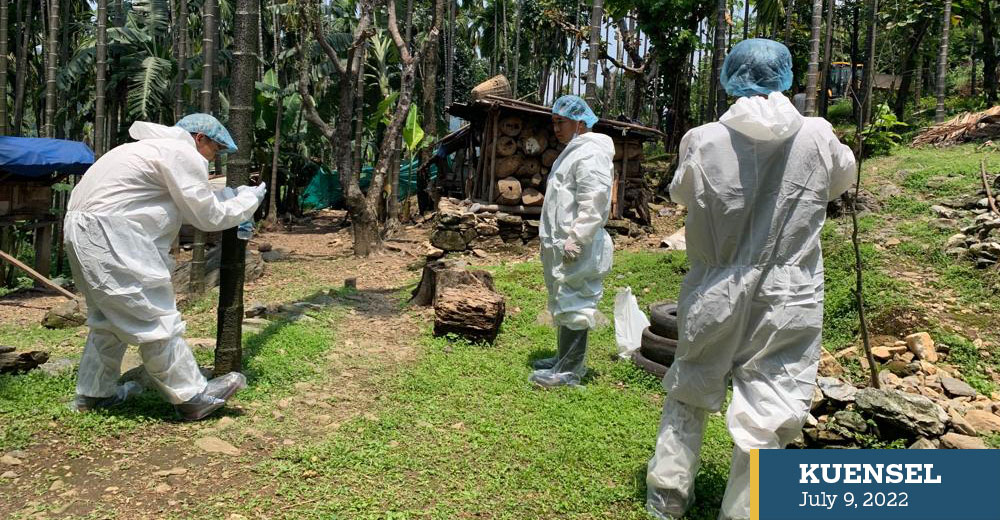Chhimi Dema
Controlling African Swine Fever (ASF) outbreaks this year cost the government more than Nu 21.2 million (M).
ASF is a contagious viral disease affecting pigs of all ages, inducing a haemorrhagic fever.
The head of disease prevention and control unit under the livestock department, Dr Sangay Rinchen, said that given the implication of ASF on the economy of the pig farming sector, it was important to respond immediately to outbreaks for timely containment of the disease.
The response, he said, involves preventive measures such as enhancing the farm biosecurity; restricting the movement of people; controlling the movement of the pigs, pig products and farm equipment within the infected area and outside.
“An important disease controlling measure is preventive culling or removal of the infected pigs and pigs at risk of infection based on scientific epidemiology assessment,” he said.
The rapid response team formed in the field conducts an epidemiology risk assessment and identifies those infected, continues surveillance, and demarcates free zones.
“These measures in place prevent the disease from spreading to other areas,” Sangay Rinchen said.
Bhutan experienced two ASF outbreaks, this year and last year.
The first outbreak in the country was in May 2021 from Phuentsholing.
Sangay Rinchen said that the outbreak was caused by stray pigs living along the borders.
A total of 34 stray pigs were infected and 21 pigs were culled to prevent the spread to domestic pigs in the country.
“With the collaboration between the department and the Bhutan Agriculture and Food Regulatory Authority the virus was contained without any outbreak in domestic pigs,” he said.
This incurred expenditure of Nu 0.9M to control the disease.
The second ASF outbreak was confirmed in April this year from Samphelling gewog in Chukha.
A total of 58 farms in the gewog were affected leading to the culling of 1,008 pigs while 47 pigs died of ASF infection.
The government while containing the second outbreak spent Nu 21.2M.
Of that about Nu 19M, Sangay Rinchen said, was spent on compensating farmers whose pigs were removed as a measure of prevention to contain the spread of the disease.
The farms were not meeting the standards or pig rearing in the fields, he added, which could have augmented the spread of ASF and entered the farms in the locality.
He added that there was a rampant and haphazard establishment of piggery and poultry farms in the community with growing demand for their products.
The second outbreak of ASF in the country was reported following the reports of outbreaks in the region including the north-eastern states of India.
Sangay Rinchen said that they could not ascertain the source of the outbreak but a probable reason could be a coexistence of pigs and cattle egrets that flew from across the border.
DoL on June 21 launched three livestock diseases (ASF, lumpy skin disease, and brucellosis) control plans.
The department’s Facebook page stated that the plans were developed given the evolving disease epidemiology and the country’s progression in the management of livestock disease.
Sangay Rinchen said that the control plan identified the relevant stakeholders’ responsibilities and processes to follow during the outbreak.
“The control plan helps in taking immediate action by the stakeholders without wasting resources and time,” he said. “The plan is to swiftly respond to an outbreak.”
The plan also specifies the compensation model.
The Food and Agriculture Organisation of the United Nations reports that ASF was first reported in the Asia-Pacific region in August 2018.
It stated that the disease has rapidly swept through the region leading to the culling of 100s of millions of pigs to control its spread, threatening food security among communities dependent on pig farming.
There is no public health risk associated with ASF.
Sangay Rinchen said that the best preventive tool is to advocate to the farmers on proper rearing practices and enhance the biosecurity of the farms. “A lapse on a farm can incur huge expenditure for the government.”
There are no effective vaccines or treatments available for the diseases currently.
According to the Livestock Statistics 2021, there are 22,954 pigs in the country.


